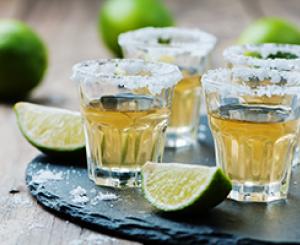
1. Why do we drink tequila with salt and lime?
In 1930, Northern Mexico was hit hard with an epidemic of Spanish influenza. Doctors at the time believed that tequila was the best remedy to fight the disease. They prescribed it with luime and salt, and with that, a tradition was born.
2. Contrary to popular belief, a worm is NEVER present in a bottle of tequila.
The governing body that presides over the rules and regulations of the tequila industry prohibits the inclusion of the worm in any tequila. This “worm” is typically either the larvae of the Agave Snout Weevil, Scyphophorus acupunctatus, or the Hypopta Agavis Moth, Hypopta agavis. These “worms” are more commonly found in mezcals, which are made in the less regulated areas.
3. All the blue agave grown for tequila comes from one region of Mexico.
The state of Jalisco and designated areas of the states of Guanajuato, Michoacán, Nayarit, or Tamaulipas are the ONLY areas designated to grow the blue agave found in tequila.
4. Tequila terroir refers to the location where the blue agave is grown and the role it plays in the tequila’s taste.
Lowlands: Soil = Volcanic-Enriched, Taste = "Spicy" in flavor
Highlands: Soil = Red Clay, Taste = More delicate, somewhat floral, mineral quality
5. The blue agave, was first described and classified by French botanist Frédéric Albert Constantin Weber in 1902.
This succulent isn’t classified as a cactus. It is more closely related to the lily and amaryllis. All tequilas are mezcals, but not all mezcals are tequilas. Mezcals are any alcohol distilled from agave species. Tequila is specialized since it can ONLY be made from the blue agave.
6. Before the fermentation process begins, the blue agave is harvested and prepared.
- coa (n.) - sharp, round-ended tool used by the harvester to cut the leaves off the head of the agave.
- tahona (n.) - traditional, large wood or stone wheel turned by donkeys, oxen, or tractors that is used to mash up the agave pulp. It produces a coarse paste and sweet sap that is fermented to make tequila.
- jimador (n.) - harvester of the agave.
- autoclave (n.) - large pressure cookers used to steam the piñas. By cooking, the sugars found in the agave begin to concentrate.
- piña (n.) - literally pineapple — after the leaves are cut off the head of the agave, it resembles the look of a pineapple.
7. Breakdown of the different types of tequila:
- 100% Agave: Tequila made exclusively from the sugars of the blue agave
- Mixto: Tequila made from a minimum of 51% blue agave. The remaining alcohol is derived from corn or cane sugar.
- Silver/Blanco/White/Platinum: Clear in color. Un-aged and bottled immediately after distillation, or aged for 2 months in stainless steel tanks or neutral oak barrels.
- Gold/Joven/Oro: Unaged silver tequila that may be flavored with caramel coloring, oak extract, clycerin, syrup, and other additives. May also be a mixture of silver and aged or silver and extra aged tequilas.
- Rested/Reposado: Aged in aok barrels for 2 to 12 months.
- Aged/Anejo: Aged in small oak barrels for 1 to 3 years.
- Extra Anejo: Aged in small oak barrels for more than 3 years.
8. There are a variety of liquids that are produced from distillation.
Tequila Terms you Need to know Part 2:
- Ordinario: (n.) Alocholic liquid produced after the first distillation. Also known as tequila primero.
- Corazon: (n.) "Heart" the most desired part of the distillate. The middle. Main protion used in tequila.
- Cabeza: (n.) "Head" first part of the distillate to come through the still. Usually discared. Also known as Punta.
- Cola: (n.) "Tail" The last portion of the distillate that is low in alcohol. Usually recycled into subsequent distillations.
9. Understanding the tequila label.
Type/Tipo: See #6 above
- Purity: Only 100% agave will be marked. All others are considered mixtos.
- CRT: Indication that the tequila regulatory council has certified production process of the tequila.
- NOM: Indicates the distiller registration number.
- Hecho En Mexico: Made in Mexico. Only 100% agave tequila can be made in Mexico.
- Alcohol Content: The proof of Mexican tequila is typically 75-80 (34%-40% Alcohol).
10. And sangrita best highlights the taste of tequila.
Sangarita:A spicy, non-alcoholic drink that is typically served as an accompaniment to tequila. The traditional method is to alternate sips between the sangrita and tequila. Various recipes exist. But it is usually a combination of:
- Orange Juice
- Lime Juice
- Tomato Juice
- Grenadine
- Chile Powder
- Fresh Chiles
- Worcestershire
- Hot Sauce
For more Tequila facts, please visit Buzzfeed.com.
